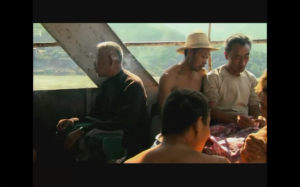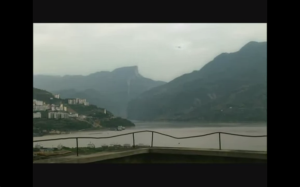By Chermaine Goh
Still Life (San Xia Hao Ren) by Jia Zhang Ke (2006, China) is a film that tells 2 different stories of 2 people who travel to Fengjie, a small town on Yangtze river, in a bid to search for their respective spouses. It is a town that is being slowly demolished due to the Three Gorges Dam.
In this film, Jia stays true to his signature style of slow pacing and having lots of panning shots. The camera sweeps through each shot slowly, enabling one to see the actions everyone in a particular frame. Through these shots, it can be seen that Jia offers a meticulous approach to his films and no details go unnoticed.
Jia is also not afraid to take risks to add in something unconventional in films. As a way to move on to the second story, he adds in a computer-generated flying saucer and a rocket shooting through the sky. The character Han Sanming looks up and there is a UFO shooting by. The shot of the UFO initiates the crossover to the next story, where the main character of that story, Shen Hong, sees the UFO zooming by as well. Till now, no one knows exactly why Jia chose to add in the shot of the UFO zooming by across the skies. Ian Thompson mentions that although he is not sure of the meaning to the UFO and the rocket, the ‘use of the former in linking Sanming and Shen Hong is economic, effective, and resonant’. (Ian Thompson, Bright Lights Film Journal)
The many shots of ‘empty landscapes and dark interiors’ (Susan Walkers, thestar.com) drew many speculations that he was inspired by Italian master Michelangelo Antonioni. Antonioni had many works about urban displacement where he liked to shoot empty urban landscapes, which is very prominently featured in this film. Also inspired by Antonioni is Jia’s expressing his ideas with images rather then dialogue and narratives.
“ The drifting, rootless men and women in many of his movies, and the wide-open, nominally empty landscapes through which they on occasion wander, further underscore the resemblances between the filmmakers.” (Manhola Dargis, The New York Times”
Due to having more panning shots of the land scape and the ordinary people, the plot pans out slower and for most part of the film, the 2 main characters are just waiting. Waiting for when their other half finally appears where they then meet up and the resolution is created. Having so many panning images of landscape and people is to show the aftereffect of building the 3 Gorges Dam in Shanxi. Examples from the film are Sanming in the relocation office, Shen Hong in the shut down state factory, and also a scene where a government officer orders the lights of new bridge to be turned on to show his guest. This scenes shows the state of Fengjia and the dire situations people are in.
In this film, there is the appearance of 4 Chinese characters for cigarettes, liqueur, tea, and candy. While some critics might argue that titles are completely random and unimportant as they are not themes, I beg to differ. As critic Ian Johnston points out, after these Chinese characters appear, the products makes an appearance and through the offerings of these products to the various different people, it shows the kind of relationship they have. Also, these 4 items represents the most common kind of addiction and pleasure in China.
Although this film focuses on two stories that do not cross paths, the characters remain connected by the culture and landscape of this place. They come across the same ruined buildings, the same surroundings. They mingle with people who are facing the same predicament of inevitably losing their homes, they eat the same food, and they treat people the same way.
In one scene, this landlord is forced to move out of his long time home, as it is about to get demolished. It is simply heartbreaking, being forced to leave and find a new place. He struggles with it, he tries to put up a fight, but ultimately, it is a losing battle and he is forced to find a new home. Perhaps this small scene might be overlooked, but this particular scene is more important then one thinks. This scene also represents all the other people that has faced similar situations and had to leave their homes because of the flooding.
Towards the end Jia has a scene where people queuing up to board ships other parts of China to lead a new life. This shows closure as the people of the town put away a part of their lives and start a new one. Closure is much needed as their home will soon be gone forever and if there is no closure, they will not be happy. Jia brings across many messages in this film, and closure is one of them.
This film is a sobering reminder that this town is slowly dying away and it will become history in a matter of years. While it is an inevitable fact that one day this town may not remain, at least bits and pieces of the town will forever remain through this film.
About The Author:
Chermaine is a sleep-deprived film and writing student studying in Singapore Polytechnic. When she isn’t working on her never-ending assignments, she will most likely be found catching up on movies and books. She suffers from severe wanderlust.
References
1. Ian Thompson. “Still, Life Looking At Jia Zhang Ke’s Recent masterpiece.” Bright Lights Film Journal. 2009. Web. 18 June 2013. <http://brightlightsfilm.com/58/58stilllife.php#.UcQB9T4ml4V>
2. Manohla Dargis. “Those Days Of Doom On The Yangtze”. The New York Times. 18 January 2008. Web. 18 June 2013. <http://movies.nytimes.com/2008/01/18/movies/18stil.html?_r=0>
3. “Still Life, 2006 film”. Wikipedia The Free Encyclopedia. 2006. Web. 18 June 2013. <http://en.wikipedia.org/wiki/Still_Life_(2006_film)>
4. Susan Walker. “Still Life: Waiting for the river to rise”. thestar.com. 25 July 2008. Web. 19 June 2013. <http://www.thestar.com/entertainment/movies/2008/01/25/still_life_waiting_for_the_river_to_rise.html>
5. “Michelangeo Antonioni” Wikipedia. Web. 19 June 2013 <http://en.wikipedia.org/wiki/Michelangelo_Antonioni>









Essay lacks focus and generalises without supporting evidences.
Eg. “For instance, the way he manipulates real time, the way he expresses ideas with images instead of through dialogue or narratives is clearly inspired by Michelangelo Antonioni.” Says who? Illustrate and prove with images from both Jia and Antonioni.
“Through the stories, much can be learnt about the Chinese culture. For instance, in the 1st story, main character Sanming made a trip to Fengjia to look for a runway wife that he bought for a hefty price. To learn that such cultures exist up to now is a learning experience.” No, you cannot generalise this way. Is this cultural significant?
What are the purpose of the two scenes you described?
In addition, you need to use your sources properly in your essay. Please read Blackboard FAQ on CA and comply accordingly.